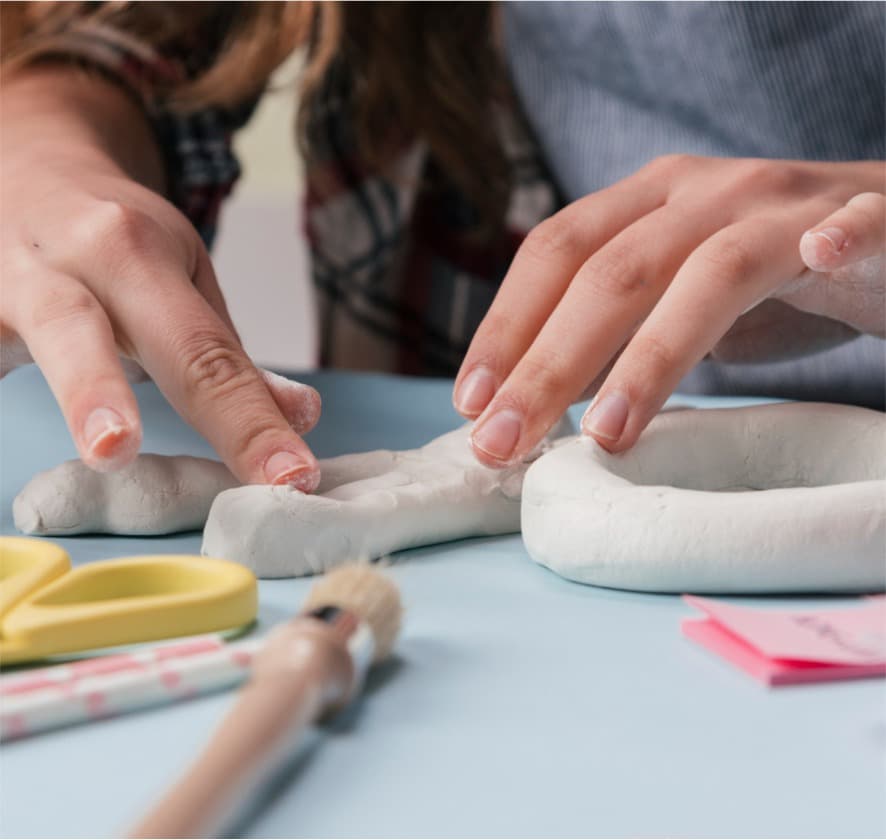
Colouring Playdough/Clay Alphabets
Class 1
 Objective
Objective
Students will be able to make alphabets using playdough/clay.
 Prerequisites
Prerequisites
1) Fine motor skills: Students should have developed the ability to manipulate playdough by rolling, squeezing, pinching and shaping it with their hands and fingers.
2) Hand and eye coordination: Students need to have coordination between their eyes and hands to shape the playdough into specific shapes or forms.
3) Hand strength: Students need to have sufficient strength in their hands to roll the playdough and cut them into sections using tools
4) Bilateral coordination: Students must have coordination between both their hands to manipulate the playdough while rolling and cutting or squeezing and pinching to give it different forms.
5) Visual perception: Students should notice and recognise subtle differences in the colours, shapes and sizes of playdough pieces or tools. They should also have the ability to place one piece of playdough on top of another or fit shapes together.
6) Follow simple instructions: Students should understand and follow simple instructions. Always use clear and concise language.
NOTE: Adaptations, Variation in Rules and Pace are suggested below to develop the above prerequisites.
 Goal
Goal
All
All children can identify the alphabets and create them with playdough/ clay themselves or with the help of the teacher/peers.
Some
Some children can roll the playdough/clay and use them to make alphabets.
Few
Few children can learn that playdough/clay can be used to make different alphabets.
Operational Definition
All – This gives the goal, which is the minimum that the teacher must achieve for all students in the classroom.
Some – This gives the goal that the teacher may try to achieve for some students in the classroom who can achieve the suggested goal over and above the goal stated for ‘All’.
Few – This gives the goal that the teacher may try to achieve for a few students in the classroom who can achieve the suggested goal over and above the goal stated for ‘Some and ‘All’.
Materials Required for Activity
Playdough/clay – Three different colours.
Preparation for Activity
Preparing will help you to conduct an effective activity in an inclusive classroom and achieve the goal.
- Download the Playdough/clay-Alphabets worksheet provided with this.
- Please ensure that all children have the worksheet ready.
- Please keep ready the Adapted Worksheet as required for your Inclusive Classroom. Details of creating these adaptations yourself is provided below.
- Go through the suggestions provided for Variation of Rules and Pace and Adaptations and ensure necessary preparation accordingly
Preparing will help you to conduct an effective activity in an inclusive classroom and achieve the goal.
Setting for the Activity
This is a classroom activity. All children can work on the worksheets individually. However, children who need peer support can work with their peers.
Procedure
- Teacher may first show the different coloured playdough that will be used in this activity.
- Ask the children to identify the colours.
- Encourage and appreciate the children for their answers.
- Demonstrate how to roll a small quantity of playdough between the palms.
- Demonstrate how to make different alphabets’ shapes in different colours.
- Demonstrate how to stick them on the working sheet.
Craft Worksheet A4: Playdough/clay-alphabets
View and DownloadEnlarged Craft Worksheet: Playdough/clay-alphabets
View and DownloadFlashcards: Colour Flashcards
View and DownloadClick and watch the videos. These videos are to be shown to children before the activity. When there are children with hearing impairment in the inclusive class, use the video with Indian Sign Language (ISL)
Video: Playdough/clay-alphabets
ISL Video: Playdough/clay-alphabets
Notes to the Teacher
- Encourage and appreciate the children for their answers.
- Go around the class and ensure that the children are following the instructions correctly at each step.
- The teacher should identify the Hand dominance of the child and encourage the child to do with that hand
- Appreciate and acknowledge children’s effort
Adaptations to address variability in an inclusive classroom
The variability of an inclusive environment needs to address the processing and attention differences among learners. An inclusive environment may include learners with visual impairments, hearing impairments, locomotor impairments and cognitive differences. Learners not only learn in different ways, but also possess unique motivations, interests, personalities and strengths. To address this variability, providing appropriate adaptations is an effective solution.
Adaptations and Strategies: Playdough/clay
Suggested Variation in Rules and Pace
When working with special children, it is important to adapt the rules and pace to their specific needs. Here are some suggestions:
- Vary the rules: Depending on the child’s abilities, you can adapt the rules for craft. For example, if a child has difficulty in rolling shapes, you could help them in making.
- Vary the pace: Some children may need more time to complete tasks than others. It may be helpful to break up the task into smaller parts, providing regular breaks or alternate activities to avoid frustration or fatigue. Using a timer can help children pace themselves and feel a sense of accomplishment as they work towards completing the task.
- Provide additional support: For children with fine motor difficulties, you can provide adaptive tools. A reference for these adaptive tools is provided in the Adaptations and Strategies Document.4) Provide positive feedback: It is important to provide positive feedback throughout the craft activity to build the child’s confidence and motivation. Be specific and provide feedback on their effort, progress, and the quality of their work.
Human Value Content – Good Habits
Video: Human Value Song–Good Habits
ISL Video: Human Value Song–Good Habits
Poster: Human Value Song-Good Habits
View and DownloadSocial Narrative – Making Craft
A social narrative is a tool used to help individuals with special needs, particularly those on the autism spectrum, better understand social situations and how to appropriately respond to them. Here is a social narrative about making craft items. The videos can be shown in an inclusive classroom.
Social Narrative (I Can Do Group Activities with My Classmates coming soon)
Click to access Social Narrative
Teacher Resource Document
View and Download| Source and Attribution of images All images used in the above Assets and Aids are originally created. |
This digital material has been developed by the Sri Sathya Sai Vidya Vahini Inclusive Education Project, a unit of Sri Sathya Sai Central Trust, Prasanthi Nilayam, as a collaborative offering in the service of our nation.
